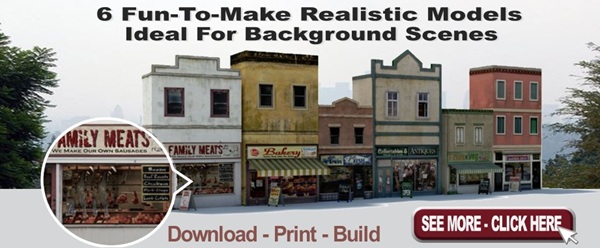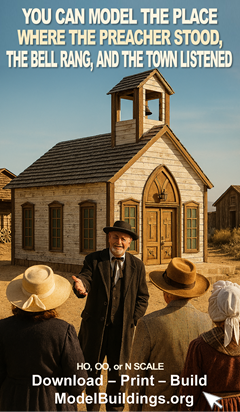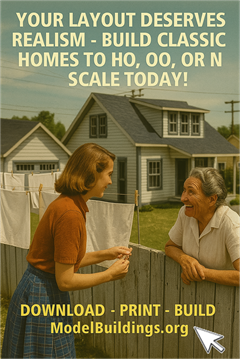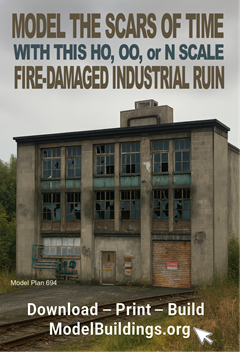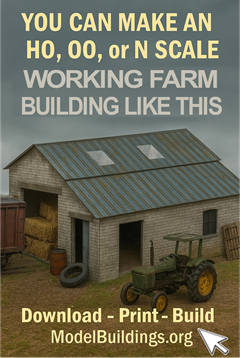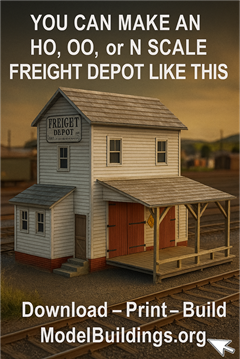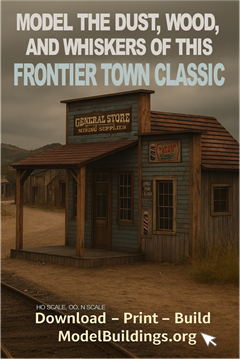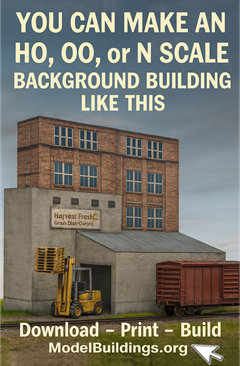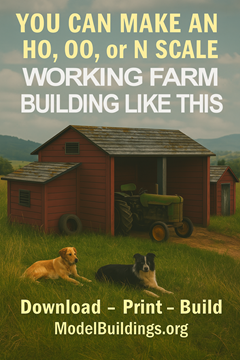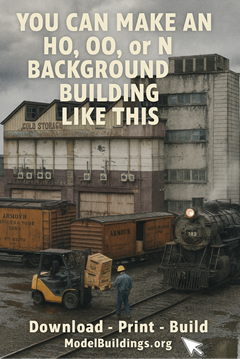Everything on model trains, model railroads, model railways, locomotives, model train layouts, scenery, wiring, DCC and more. Enjoy the world's best hobby... model railroading!
MRC Power Booster Hook Up
Dale has this question for anyone with MRC Power Booster experience:
“I decided to get back into Model railroading and bought a MRC Prodigy Express2 system. After finding out what I should have, I went with larger system for my layout. I would like to buy the MRC power booster and have a question on the hook up. Do I have to split my main tracks up by districts or can I just use the booster to increase my available amps?”
Feasibility of 4% Grade
Pete asks:
I have done my HO layout using 2% Grades however one section just does not meet my elevation criteria. I run fairly short trains – 7-10 freight cars pulled by a two loco consist. Will a 4% grade that matches my prototype work?

New Designs Include 2 Grain Elevators, a Rural Train Station, US Style Barn, and a Large Barn/Stables Building
The Combined Farms Pool Elevator and the Farmers Coop Store & Transport structures pictured below are among 7 new designs just released for railroading enthusiasts and diorama model builders. The downloaded PDF plans can be constructed using cardboard (a recycled cereal pack is ideal) to OO gauge size, HO scale or N scale. Although not really necessary, some modelers might prefer to glue scrap pieces of card or corflute inside the models for additional strength. It’s easy to do. Texture is provided for the posts pictured on the loading bay of the Farmers Coop Store & Transport building, but using pieces of balsa wood that can be painted to the color of your choice is probably the easiest method for making the posts. The designs are all pre-weathered with rust marks, windows, dirt and grime etc.
The new series also include a small country train station which could serve other purposes too, as well as a tall red stable barn building complete with outside toilet (or storage shed), and a tradition US style red barn structure. These too can be made to OO, HO, S, or N scale. The plans can be downloaded from the website https://www.modelbuildings.org See more on the website.
NEW! Just Released – Tractor Equipment Shed, and Rural Freight Depot Designs To Download and Build
7 new plans have just been added to the existing range of farm buildings that can be made to HO scale, OO gauge, or to N scale. There are two new grain silos, a tractor/equipment shed (pictured above), a traditional US style barn, a large red stable/barn, a small rural station, and a rural freight depot (which could have a number of uses). The PDF plans are simple and quick to download, print, ready for construction using card.
See the new designs at https://www.modelbuildings.org
Cover for DCC Drop in Boards
David has this question:
“Does anyone know where to buy the plastic slip-on cover for DCC drop in boards?”
Fleischmann Profi-Track and American Rolling Stock
Don who model in HO asks:
“I have a very large collection of Fleischmann profi track and turnouts. My layout is an around the room. My Walthers SD60 locomotives run without problems through all turnouts and track. My cars on the other hand derail almost everywhere even on some straight sections. I have inspected the track where the derailments occur and have discovered nothing out of the ordinary. I am getting frustrated. I have spend a great deal of money on the Fleischmann Profi. But I don’t want to spend all of my time fixing derailments. Any help would be greatly appreciated. I am using Walthers rolling stock of various sizes with metal wheels and Walthers couplers. Thanks for your thoughts and help.”
N Scale Ballast Quantity
Steve asks:
“When purchasing fine ballast for N scale track, how much track can be completed with a ballast package. Or, how much should I expect to use per 3’ section of track?”
Power and Rail Length Limitations
Bob asks:
“Greetings, I am looking to return to model railroading after many years. Due to space limitations indoors, I am looking to build outdoor layout. Cost factors have me looking at nickle track HO. If I read correctly the newer DCC presents options. I am looking to see how many feet or meters of track can be supplied per power source? Any other support information is gladly welcomed.”
Converting Märklin Stock to Run on DC Platform
Ed asks:
“I have a number of HO Märklin cars that I would like to convert wheels and couplers to be usable with my DC engines and cars. Can anyone advise me how best to make these conversions – suggest the couplers to use and how to change out the wheels, including what wheels to buy? Thanks a lot.”
Locomotive Goes in One Direction Only?
Roger W posted this question:
“My Athearn DCC loco I picked up at a swap meet has issues, and I’m not sure of the cause. It has been sitting in a cupboard since I got it so perhaps I got a dud. It goes fine in reverse but won’t move very well going forward. I turned the power right up to 28 and it hardly moved before coming to a halt. The unit hums but nothing. I gave it a bit of a push and the motor tried to turn but it still hardly moved. I tried different decoders and even reset the factory values on one, but to no avail. I had a look under the shell and at the trucks, but could see any foreign objects getting in the way. What am I missing? Help appreciated please. Thanks in advance guys.”
If you can assist Roger please add a comment.
Helix Calculations For Double Track
Joe came across the free helix calculator and is interested to hear from anyone who has constructed a double track helix layout:
“Can a helix calculator be used for a double track layout? What modification, if any, would need to be made?”
Add your comments if you have any advice for Joe with the construction of his double track helix.
A link to use a free helix calculator is available for readers under the Railroad Resources tab in the top Navigation Bar at https://www.modelbuildings.org
A Issue With Drooping Couplers or is Couple Height The Problem?
Warren asks readers:
“I have observed that some of my HO Kadee couplers are sagging a bit low on two locos. I notice one coupler shank seems a bit loose in the coupler box and at times angles down towards the rail. Is there a way to fix this? How high should my couplers be? Advice please someone.”
Add you comments below.
Hand-Laying Track
Dale asks readers:
“Hand-laying HO track is fairly easy; simply spike the rails to the ties (sleepers). Does anyone have experience hand-laying N scale, code 80, track? Are the spikes going to be strong enough, or is it better to glue the rails down?”
Add your comment below.
ANZAC TRIBUTE
April 25th Tribute. Anzac Day marks the anniversary of the first campaign which led to major casualties for Australian and New Zealand forces during the First World War. The acronym ANZAC stands for Australian and New Zealand Army Corps, whose soldiers were known as Anzacs. Sadly, due to COVID 19 the normal dawn services held across both New Zealand and Australia on April 25 cannot be held. This year hundreds of thousands of Kiwis and Aussies are likely to stand together at driveways on Anzac Day to commemorate the fallen and those who served their nations.
Below is a photo of an old New Zealand railcar that came into service between 1954 and 1958.
Below is a 1970’s commuter train that operated in Sydney, Australia.
Pontefract Model Railway Exhibition Remembered
Ian took this photo, but he’s not sure what year it was, of the Pontefract Model Railway Exhibition in the UK. If some can place the scene and time, maybe they can share a comment.
Thanks for sharing.
Remembering The Cardiff Model Railway Show
Cory shares this photo he snapped at the Cardiff Model Railway Show in the UK that he attended some time back. The 34th Cardiff Model Railway Exhibition is scheduled for 17th & 18th October 2020 all going well.
Cane Train In Queensland Australia
Roy sent in this photo to share of a sugar cane train on display a few years ago at the Castle Hill Model Railway Exhibition held in New South Wales, Australia. The cane trains still run in Queensland.
Sadly Most Train Shows Are Cancelled
Unfortunately this dreadful COVID 19 virus has forced the cancellation of model train shows worldwide, and it has forced most of us (depending which country you are) to stay indoors.
Don’t let that stop us…
Unlike so many others, we model railroading enthusiasts, have a wonderful pastime to keep us busy and entertained during these testing times. With that in mind; I’m sure other readers would love to hear what you have been up to, and the progress you have made on your layout. Hopefully this will help inspire others in the model railroading community, and help keep us all positive (and sane) at this time.
Just use the ASK A QUESTION link below to send a summary of what project you have been working on (it doesn’t need to be a question). Even better if you can supply a supporting photo that can be shared on the blog.
If you have a photo, we can advise you how to send it to us for uploading on the blog. The first step is to send in a brief summary of your project, and at the same time if you have a photo just let us know. We will then reply to you by email. I’m sure others would like to see what you are up to.
This photo was sent by a reader who visited the Southwold Model Railway Exhibition organised by Waveney Valley Model Railway Club a couple of years ago. Feel free to send in a photo you snapped at a train show in recent years. Let us know the details using the ASK A QUESTION link, and we will be in touch telling you how to email us your photo.
